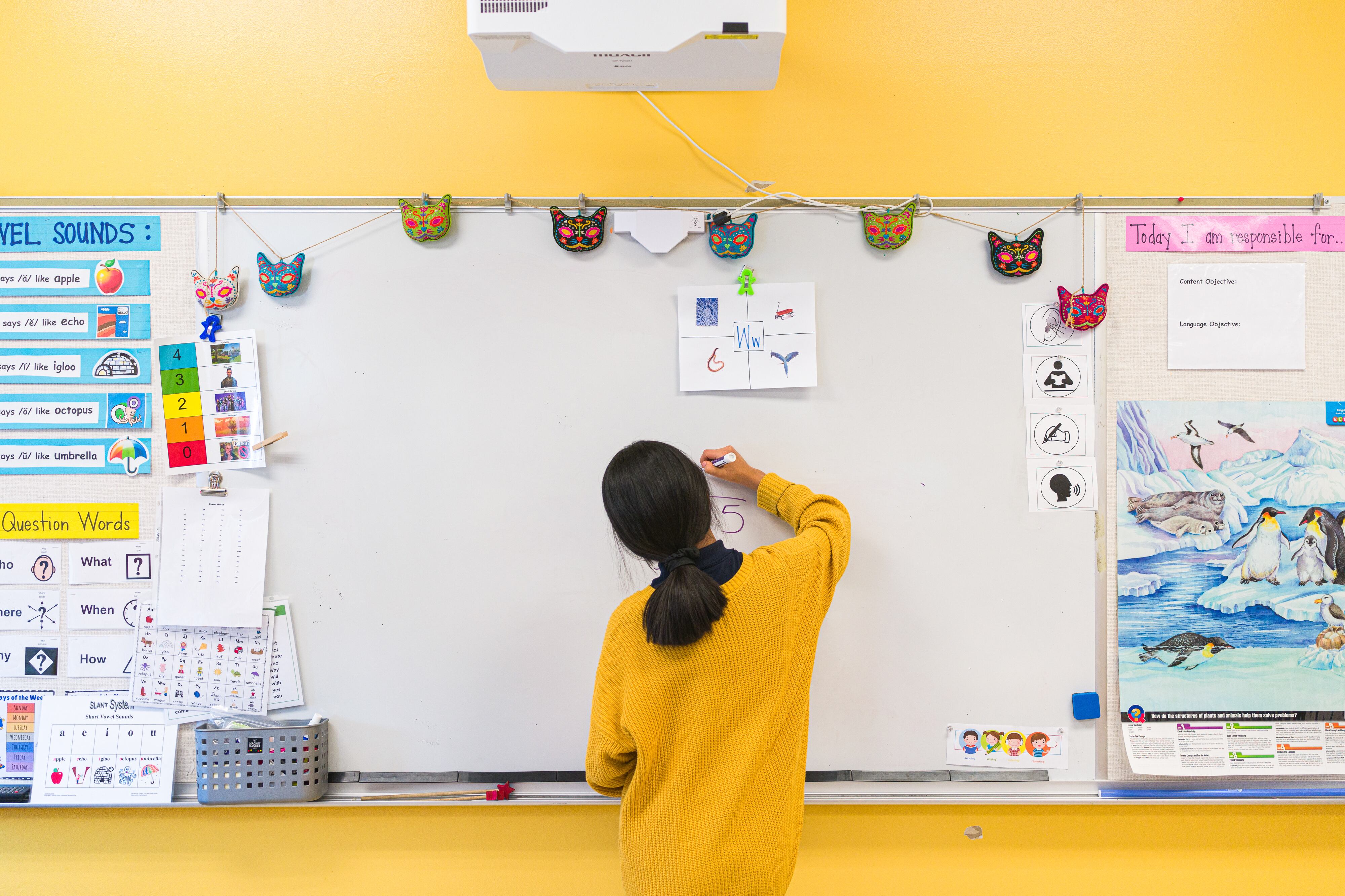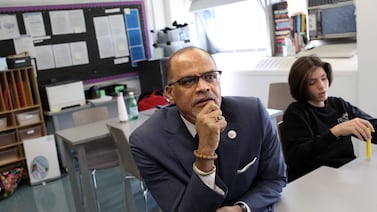When Sara Holmes works with students, she takes them outside to observe the weather. Or she brings in objects from outside the classroom, like shells from the beach, to describe and discuss.
As an English language collaborative teacher at North Elementary in Noblesville, she’s responsible for helping around 20 English learner students develop their language skills — a role now required in every Indiana district.
But three years after new staffing guidelines were first announced, it’s not clear if there are enough teachers like Holmes. In fact, in the 2021-22 school year, one-third of districts and two-thirds of charter schools statewide reported not having any licensed English learner teachers.
It’s a critical deficit in a state that this summer reported an 8.5 percentage point drop in reading scores among third-graders who are learning English, while scores for most other groups rose or stayed flat. The population of English learners in the state has also grown dramatically in recent years, increasing by 52% between 2017 and 2022 to around 72,000 students.
Hampering schools is a larger staffing shortage in the state that makes it difficult to fill open teaching positions. Some districts also point to funding shortfalls keeping them from hiring enough teachers to meet the recommended ratios of English learner teachers to students.
And COVID-related upheaval threw a wrench in the works at schools that could find both teachers willing to get certified to teach English learners, and the funding to pay for their coursework.
But the Indiana Department of Education cautions that schools that don’t meet the requirements could be found out of compliance with federal law — and risk losing their federal funding. That could mirror the state’s struggle to comply with special education staffing requirements last year.
Most importantly, students who attend schools without enough teachers may get a worse education, with less instructional time and individualized attention from teachers who must travel between schools and teach to larger-than-recommended groups.
Federal rules for English learner staff
Under federal law, all schools have an obligation to adequately staff their English learner programs, which includes hiring trained teachers or training their existing staff to work with English learners.
The teachers are responsible for a student’s English language development, either directly, or through coordination with other teachers. They develop the weekly instruction that students are required to have and analyze how students progress on their goals.
Beyond their day-to-day responsibilities, the teachers serve their schools as experts on language acquisition, said Kathryn Brooks, a professor at the College of Education at Butler University.
“It’s useful not just for multilingual students but all students developing language skills,” she said.
But Indiana has struggled with this obligation. A 2019 memo from the Indiana Department of Education reported that half of Indiana districts had no “English as a New Language” teacher on staff during the 2018-19 school year, while more than 90% of districts had at least one English learner enrolled.
The memo rolled out new staffing rules requiring all districts to hire an English as a New Language Teacher of Record — an educator responsible for overseeing students’ English language development. Schools had until Sept. 1, 2022 to meet the requirement.
They could do so by hiring a licensed teacher, or a teacher to fill the role on an emergency permit. They could also identify a teacher with experience in English learner education to serve in the role under a state-issued rubric.
And districts with low populations of English learner students could share a teacher between them, if the teacher could still provide each student at least 30 minutes of English language development four to five days a week — a baseline requirement from the federal Office for Civil Rights.
In order to meet this requirement, the state education department recommends that teachers have no more than 30 students. That’s a suggestion some teachers would like to see codified into law.
There is no exception to the staffing rules for districts that don’t have any English learners enrolled, according to the state, because an English learner student may enroll in the future and schools must be prepared to teach them.
What state data shows now
A Chalkbeat analysis of state data from the 2021-22 school year found that the vast majority of English learner students at district schools in Indiana — 98% — had at least one licensed English learner teacher in their district. Two-thirds of all districts statewide report having at least one such teacher.
But school-level data indicates these teachers might be stretched thin. Half of all district schools report not having an English learner teacher, which could show that some teachers are traveling between schools to see all students.
In practice, teachers say this can cut into their teaching time, and require them to meet students in large groups that don’t allow for individualized instruction based on the student’s language level.
Meanwhile, two-thirds of Indiana’s charter schools reported not having an English learner teacher. Around 55% of English learners at charter schools are at schools that have at least one English learner teacher.
While both district and charter schools report having English learner teachers on emergency permits as well, all of those instances are at schools that already have a fully licensed English learner teacher.
The available data doesn’t tell the whole story. Some teachers may be shared by districts through interlocal agreements, expanding their reach.
And some schools and districts may be meeting the staffing requirements via the state rubric option — but those numbers are still being collected by the state and won’t be available until December.
Many of the state’s bilingual immersion schools meet the staffing requirements via the rubric option, according to the state department of education, recognizing their teachers’ years of experience.
A statement from the department said the number of educators holding an English as a New Language license has grown 38% from 2019 to 2021, with a total of 2,289 such educators in the state in 2021.
Numbers for 2022 will be released later this year.
COVID disrupts a district’s progress
When the state first announced new staffing guidelines, Portage schools took advantage of a state grant that allowed their staff to earn additional certification to teach English learners.
By January 2020, Linda Williams, the district’s director of grants and assessments, had identified 10 candidates to take Purdue University coursework, with the state education department paying the bill. One of the draws is that completing the program gets them halfway through a master’s degree, she said.
But COVID-related school closures in March meant that those teachers suddenly had more on their plates and less time for the additional classes. The pool of 10 eventually shrunk to three, Williams said.
In 2021, another four teachers in the district completed the program. But by this year, the state grant had expired, and Williams had to find the funding for nine more candidates to go through the Purdue program herself.
The cost is around $6,600 per teacher, funded through a combination of other state and federal grants, she said.
Still, the district’s efforts have brought it close to the state-recommended ratio of one teacher for every 30 students.
“But that’s only one piece of the puzzle,” Williams said. “The math works out. But kids are spread across different buildings. I’d like to have at least one [English language learner] licensed teacher at every building.”
Reinstating the state education department grant would help the district fund more teachers, Williams said. In a statement, the department said it’s evaluating whether to revive the grant.
Other districts like Fort Wayne told legislators earlier this month that chronic under-funding of English learner education has left them unable to meet recommended staffing ratios.
But Williams added that even with the juggling she’s had to do with grants, funding is less of a challenge for Portage than recruiting teachers.
Fewer teacher candidates mean hiring challenges
The rate of teacher retirements in Indiana has accelerated recently, while fewer candidates are entering teacher preparation programs. Among other things, that’s led to fewer teachers in high-need areas like special education and English learner education.
“I have school districts calling me to ask, do you have anybody available?” said Brooks, of Butler University. “But they’ve already found jobs in March and April.”
Brooks said Butler’s licensure program for teachers of English learners has added around 90 teachers to the workforce over the past five years. Candidates typically have teaching licenses and are looking to add on an English as a new language component.
Around 20% to 30% of candidates in the program have some prior experience with English learner students, or have served on emergency permits in schools and are seeking their full licensure, she said.
And most graduates go on to work as English learner teachers, Brooks said. But some are subject-area teachers seeking only to get better at teaching their multilingual students, she added, and don’t want the additional licensure for fear that they’ll be required to step in as teachers of record.
Ultimately, there’s a critical need not only for more English language learner teachers, but for a broader understanding of the needs of students who are learning English, Brooks said.
‘Everyone is a language learner’
Without English learner teachers on hand, schools may make curriculum decisions that aren’t backed by research, she said, and multilingual students might end up working with educators who are unprepared to teach them.
Even when schools use research-based practices — like Indiana’s push to implement the “science of reading” — studies have shown there are additional factors that affect English learners’ success, such as whether they learned to read in their first language, Brooks said.
Those students may also need extra time to become familiar with phonetic sounds that aren’t present in their first language, for example.
“A trained teacher will add or modify curriculum to target the needs of multilingual learners,” Brooks said.
Holmes, the Noblesville teacher, said one of the biggest changes she’s seen in her decade of teaching is in the emphasis on training all teachers on how to work with multilingual students. Part of her job includes leading professional development for her colleagues — and keeping up with changing research herself.
For example, although she once pulled her students out of their classrooms for small group intervention, she now follows the recommended method of teaching alongside a classroom teacher, she said.
“What we’re trying to get everyone’s mindset to switch to is that everyone is a language learner,” she said.
Holmes credited Noblesville schools with incorporating co-teaching, meeting staffing requirements, and embracing books with diverse characters that are meaningful to her students. But she said she worries for students and teachers at districts that haven’t done as much.
“I think the districts that have taken it seriously and have done it well have invested in hiring staff and making sure their staff is trained,” Holmes said. “Teachers want to know what to do. They want to know: How do we best reach these kids?”
If you are having trouble viewing this form, go here.
Aleksandra Appleton covers Indiana education policy and writes about K-12 schools across the state. Contact her at aappleton@chalkbeat.org.








